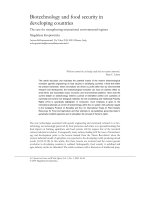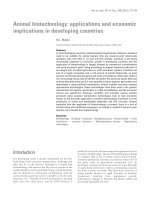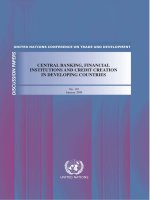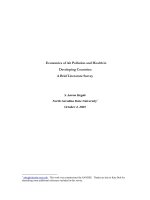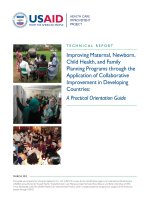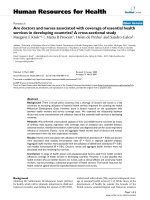Foreign investment inflows, government institutions, external openness, and economic growth in developing countries a theoretical and empirical investigation
Bạn đang xem bản rút gọn của tài liệu. Xem và tải ngay bản đầy đủ của tài liệu tại đây (615.14 KB, 157 trang )
i
FOREIGN INVESTMENT INFLOWS, GOVERNMENT
INSTITUTIONS, EXTERNAL OPENNESS AND ECONOMIC
GROWTH IN DEVELOPING COUNTRIES: A THEORETICAL
AND EMPIRICAL INVESTIGATION
O G DAYARATNA BANDA
[BA (Hons) Econ., MPhil., Econ.]
A THESIS SUBMITTED
FOR THE DEGREE OF DOCTOR OF PHILOSOPHY
DEPARTMENT OF ECONOMICS
NATIONAL UNIVERSITY OF SINGAPORE
2005
i
ACKNOWLEDGEMENTS
First of all, I express my gratitude to the thesis supervisors Associate Professor
Shandre Thangavelu and Associate Professor Tilak Abeysinghe for providing untiring
guidance for writing the thesis.
I would like to thank the administrative staff of the Department of Economics in
the National University of Singapore for their support.
I would like to acknowledge the support extended by Professors W. M. Sirisena,
W. M. Tilakaratne, M. O. A. de Soysa, and Vijitha Nanayakkara (all in University of
Peradeniya, Sri Lanka) and the members of the Department of Economics, University of
Peradeniya. I tender my appreciation to the University of Peradeniya for providing me
with study leave to pursue graduate studies.
I am also grateful to all my friends for supporting me in various respects during
this period. My special thanks go to Malitha, Lesly, and Dumindu whose generosity
enabled my family to stay with me in Singapore.
I would also like to thank my wonderful wife, Mal, who tirelessly looked after the
family matters. Most of all, I must thank my cute little son, Vaasala, who always gives
reasons for me to smile.
Last but not least, I do hereby pay tribute to the National University of Singapore
for granting me the NUS Research Scholarship. Moreover, the excellent support facilities
provided by the University immensely helped in undertaking the research.
O G Dayaratna Banda,
Singapore, 2005
ii
TABLE OF CONTENTS
Acknowledgements i
Table of Contents ii - v
Summary vi - vii
List of Tables viii - ix
List of Figures x
CHAPTER-I
INTRODUCTION
1. 1. Background of the Research 1
1. 2. Statement of the Research Problem 1 - 3
1. 3. The Outline 3 - 5
CHAPTE-II
SOURCES OF ECONOMIC GROWTH: A REVIEW OF EXISTING
IDEAS
2.1. Classical Views 6
2. 2. Neo-classical Ideas 6 - 7
2. 3. Endogenous Technology Change and Growth 7
2. 4. Ideas Pertinent to Developing Economies
2. 4. 1. Human Capital 8
2. 4. 2. Role of Geographical Factors 8 - 9
iii
2. 4. 3. Economic Performance and Cultural Values 9 - 10
2. 4. 4. Role of Political Freedom in Economic Performance 10 - 11
2. 4. 5. Economic Freedom 11
2. 4. 6. Domestic Policies 12
2. 4. 7. Government Institutions 12 - 13
2. 4. 8. External Openness 13 - 14
2. 5. Concluding Remarks 14
CHAPTER-III
ASSESSING THE IMPACT OF FOREIGN OFFICIAL DEVELOPMENT
ASSISTANCE ON FOREIGN DIRECT INVESTMENT: AN EMPIRICAL
STUDY
3. 1. Introduction 15 - 20
3. 2. The Empirical Methodology
3. 2. 1. Empirical Models 20 - 25
3. 2. 2. Description of Variables and Data 26 - 29
3. 3. Results and Discussion
3. 3. 1. Results of Cross-Sectional Regressions 30 - 33
3. 3. 2. Results of GLS and GMM Estimation 33 - 36
3. 4. Concluding Remarks 36 - 37
iv
CHAPTER-IV
EFFECTS OF GOVERNMENT INSTITUTIONS, EXTERNAL
OPENNESS, AND FOREIGN DIRECT INVESTMENT ON ECONOMIC
GROWTH: A THEORETICAL FORMULATION AND A CROSS-
COUNTRY EMPIRICAL STUDY
4. 1. Introduction 38 - 41
4. 2. The Model
4. 2. 1. Version-I:- Government Institutions Production Spillovers:
A Two-Sector Model 41 - 49
4. 2. 2. Version-II:- Private Export Production Spillovers:
A Three-Sector Model 49 - 58
4. 3. Empirical Investigation
4. 3. 1. The Empirical Models 58 - 60
4. 4. Empirical Results and Discussion 61 - 69
4. 5. Concluding Remarks 69 - 70
CHAPTER-V
ENDOGENOUS GOVERNMENT INSTITUTIONS AND EXTERNAL
OPENNESS IN A GROWTH MODEL
5. 1. Introduction 71 - 73
5. 2. The Model
5. 2. 1. The Structure of the Model 73 - 76
v
5. 2. 2. Exogenous Government Institutions and External Openness 76 - 79
5. 2. 3. Endogenous Government Institutions and External Openness 79 - 93
CHAPTER-VI
IN QUEST FOR PUZZLING GROWTH PERFORMANCE IN SRI
LANKA: A CASE STUDY
6. 1. Introduction 94 - 97
6. 2. Foreign Investment 97 - 99
6. 3. Pressure of High Inflation 99 - 100
6. 4. External Openness 100 - 103
6. 5. Government Institutions 104 - 109
6. 6. Determinants of Economic Growth: Regressions 109 - 112
6. 7. Concluding Remarks 112 - 113
CHAPTER-VII
POLICY IMPLICATION
7. 1. Introduction 114
7. 2. Improving the Incentive Structure for FDI Inflows 114 - 116
7. 3. Promoting Growth: Institutions and External Openness 117 - 124
Bibliography 125 - 135
Appendices 136 - 146
vi
SUMMARY
This study focuses on examining two main issues related to economic growth in
developing economies. First, the study investigates as to whether or not there is any
systematic relationship between foreign official development assistance inflows (FDA)
and foreign direct investment (FDI) inflows into developing economies. In order to
investigate this issue, this study undertook an empirical study by employing panel
framework for a sample of developing economies. The results of the study show that the
relationship between aggregate FDA and FDI is ambiguous. Multilateral FDA has a
negative impact on FDI inflows, whereas bilateral FDA positively affects FDI inflows.
Furthermore, the empirical results suggest that government investment in infrastructure,
external openness, and government institutions are important determinants of FDI
inflows into developing economies. These findings indicate that the overall incentive
structure of the economy that hosts FDI is the key for attracting FDI.
The second objective of this study was to examine the mechanism(s) through
which government institutions and external openness foster economic growth. Effects of
government institutions and openness on growth are derived using a three sector model in
the Neo-Classical growth framework that was supported by an empirical investigation
using dynamic panel framework. According to the theoretical formulation, FDI, trade,
and government institutions exhibit positive spillover and externalities onto the domestic
economy, thereby leading to productivity improvements and economic growth. Empirical
results of panel study show that FDI unambiguously positively impact on economic
growth. The government institutions, trade, and FDI inflows positively contribute to
economic growth in developing economies. A case study on Sri Lanka strongly supports
vii
the theoretical as well as empirical findings. The study also attempts to explain the role of
endogenous institutions and external openness through a growth model. According to the
set-up of the model, the government institutions and external openness induce incentives
for undertaking R&D works by reducing rent-seeking activities and hence tend to foster
economic growth. The results show that the economies devote more resources to building
institutions, maintaining favorable external economic policies tend to increase R&D and
to maintain higher growth.
According to the findings of the thesis, government institutions and external
openness are complementary determinants of economic growth. The main policy
implication emerging from the findings of the study is that the developing economies
must have to devote resources to improve the strengths of government institutions, and to
adopt more open external economic regimes both for attracting FDI as well as for
fostering economic growth.
viii
LIST OF TABLES
Table 3.1: Modeling Foreign Direct Investment by OLS and 2SLS 31
Table 3.2: Modeling FDI by OLS and 2SLS 32
Table 3.3: Modeling FDI by GLS and GMM 34
Table 3.4: Modeling FDI by GLS and GMM 35
Table 4.1: Modeling Economic Growth by LSDV and GLS 61
Table 4.2: Modeling Economic Growth by LSDV and GLS 62
Table 4.3: Modeling Economic Growth by LSDV and GLS
with Interaction Term 63
Table 4.4: Modeling Economic Growth by GMM 64
Table 4.5: Correlation Matrix 65
Table 4.6: Determinants of Growth of GDP by GMM 66
Table 4.7: Correlation Matrix 66
Table 4.8: Modeling Economic Growth by GMM 67
Table 4.9: Modeling Economic Growth by GMM 68
Table 4.10: Modeling Economic Growth by GMM 69
Table 6.1: FDA as a Percentage of GDP 98
Table 6.2: FDI Inflows as a Percentage of GDP 98
Table 6.3: Trade Distortions, Export Tariffs
(% of Government’s Tax Revenue) 102
Table 6.4: Degree of External Openness: Trade Openness Index 103
Table 6.5: Strengths of Government Institutions: Separate Indexes 106
Table 6.6: Composite Index of Government Institutions 107
ix
Table 6.7: Growth Performance and Policy Regimes in Sri Lanka:
Growth of Per-capita GDP (Period Averages) 108
Table 6.8: Determinants of GDP Growth Rate 111
Table 6.9: The Determinants of Growth of GDP Per-capita in Sri Lanka 112
x
LIST OF FIGURES
Figure 6.1: Enormous Divergence of Per-capita Income
(Korea, Malaysia, Singapore, Sri Lanka) 95
Figure 6.2: Scatter with Nearest Neighbor Fit between multilateral
FDA and FDI Inflows (1960-2001) 99
Figure 6.3: Trade Share an Imperfect Measure of Openness 101
Figure 7.1: Openness and Institutions as Complementary Determinants 118
1
CHAPTER-I
INTRODUCTION
1. 1. Background of the Research
One of the most central questions in economics over the years has been why some
countries are poor than the others. A vast majority of economies in the world today are
seemingly experiencing economic destitution whereas a few countries are experiencing
the fruits of prosperity. Economists have endeavored to explore the nature and the causes
of economic growth for explaining the path to prosperity. As a result, numerous
determinants of economic growth have been established in macroeconomic growth theory
and policy. There has seemingly been increased attention on the role of foreign
investment, openness and institutions in growth. Though recent developments of this
literature have generated insights relevant for explaining the general characteristics of
developing economies, the extended research is necessary in this area. This thesis studies
the role of foreign investment inflows, government institutions, external openness and
their interaction in economic growth pertaining to developing economies.
1. 2. Statement of the Research Problems
Foreign investment inflows have always been emphasized as being one of the
main drivers of economic growth in developing economies. A few rapidly growing
countries, especially the newly industrializing economies, have attracted a greater share
of private foreign investment whereas a bulk of developing countries have relied on
foreign public sources for financing development for the last few decades. Most
developing countries with poor economic conditions and severe macroeconomic
2
problems have tended to seek foreign official development assistance (FDA) from
multilateral as well as bilateral sources for financing development since private foreign
investment has not been adequately forthcoming into such economies. This motivates one
to ponder whether FDA plays an informational role for private foreign investment. In
searching for the potential host economies, foreign investors appear to be using FDA to
detect the investment climates for increasing investment. Conversely, investment
originating countries may be using FDA as an instrument for developing trade and
investment relations with developing countries. This provides the motivation to explore
the connection between FDA and FDI inflows in developing countries. Though there are
studies explaining the possible relationship between FDA and private capital inflows
ending up with inconclusive results, there is avenue for further scrutiny for uncovering
the relationship between FDA and FDI inflows.
This provides the motivation for formulating the following research question so as
to uncover the possible link between FDA and FDI inflows in developing economies:
Question-1: Is there any systematic relationship between foreign official development
assistance inflows and foreign direct investment inflows?
There has seemingly been an unresolved controversy over the importance of
external openness and government institutions in fostering economic growth. While some
argue that institutions are fundamental determinants of growth devaluing the role of
external openness, others argue in favour of a greater role for external openness.
However, both external openness and government institutions appear to be crucially
3
important for fostering economic growth. Government institutions appear to be vital for
the well-functioning of the market economy. Strengths of government institutions are
manifested by such things as property rights, rule of law, ethnic and social harmony, and
the bureaucracy. They tend to generate externalities and spillovers. External openness is
likely to generate positive externalities and increase productivity by offering greater
economies of scale, alleviating foreign exchange constraints, transferring labour skills
into the domestic economy, diffusing technology through foreign capital and intermediate
goods. Seemingly, there are feedbacks between external openness and government
institutions. Though the existing literature has generated important insights, the empirics
of the relationship between government institutions, external openness, their interactions
and economic growth are inconclusive, whereas the theoretical literature is still at the
fledgling stage. This gives the motivation for studying the role of external openness and
government institutions in economic growth. The study formulates the following research
question.
Question-2: Do government institutions and external openness play a critical role in
economic growth? What are the likely mechanism(s) through which they could stimulate
economic growth?
1. 3. The Outline
The research issues raised above are addressed in four analytical chapters.
Theoretical formulations are also undertaken. The empirical techniques used in the
analysis are presented and discussed in the respective chapters.
4
Chapter-2:- Sources of Economic Growth: A Review of Existing Ideas
This chapter briefly reviews the existing literature on the sources of economic
growth. The review focuses on recent developments with specific attention to their
relevance for developing countries.
Chapter-3:- Assessing the Impact of Foreign Official Development Assistance on
Foreign Direct Investment: An Empirical Study
This chapter attempts to explain whether FDA inflows impact on FDI inflows in
developing countries focusing on the incentive structure of the host economies.
Aggregated as well as disaggregated data for FDA is used in the analysis. The dynamic
panel framework is employed for a sample of developing countries. While studying the
relationship between FDA and FDI, the thesis will mainly focus on the incentive structure
necessary for attracting FDI inflows into developing countries.
Chapter-4:- Effects of Government Institutions, External Openness and Foreign
Direct Investment on Economic Growth: A Theoretical Formulation and a Cross-
Country Empirical Study
An empirically employable growth equation is derived from a three-sector model
to explain possible channels though which external openness and government institutions
foster economic growth. The theoretical model focuses on explaining inter-sectoral
externalities as a channel through which external openness and government institutions
affect growth. An empirical investigation is, then, undertaken using dynamic panel
techniques drawing data for a sample of developing economies.
5
Chapter-5:- Endogenous Government Institutions and External Openness in a
Growth Model
In this chapter, an existing R&D based growth model is modified to explain the
role of endogenous external openness and government institutions in economic growth. It
focuses on explaining as to whether or not external openness and government institutions
tend to contribute to reducing rent-seeking and foster innovations leading to economic
growth.
Chapter-6:- In Quest for Puzzling Growth Performance in Sri Lanka: A Case Study
In order to relate the cross-country empirical findings of this study into a case of a
particular developing country, this chapter reviews the growth experience of Sri Lanka.
Being relatively a market-oriented and outward-oriented economy and a liberal
democracy with relatively improved institutions, Sri Lanka provides a good case for
studying the relationship between government institutions, external openness and
economic growth in a developing country setup.
Chapter-7:- Policy Implication
This chapter summarizes the findings of the study and then presents the policy
implication relevant for developing countries. The exercise reiterates that the developing
countries must improve the incentive structure for attracting FDI. It then proposes that
developing countries need to adopt a growth strategy consisting of strong government
institutions and greater openness to foster economic growth.
6
CHAPTER-II
SOURCES OF ECONOMIC GROWTH: A REVIEW OF EXISTING
INDEAS
2.1. Classical Views
Since the era of classical economists, many researchers have sought to discover
what makes a nation wealthy. Adam Smith argued in that growth was caused by
increasing either of the factors such as land, labour, and machinery. The impact of labour
on growth is induced by more efficient machinery. Increases in the workforce derived
from increasing returns resulting from growing specialization tend to increase wealth.
Physical capital depends on continuing investment by the capital-owners. Additional land
could be acquired through invasion, or existing land utilized more efficiently by
developing techniques.
2. 2. Neo-classical Ideas
Providing more coherent foundation to the ideas of classical thinkers, the
economists in the second generation simplified the model consisting of a production
function equation in which output was the product of labour and capital (Solow1956).
Taking the actual growth of the economy to be exogenous to the model, output increased
in proportionate to the increases of capital and/or labour. The neo-classical model
excluded technological progress from analysis making it exogenous to the model. The
focus was on what causes and affects the output at a certain time.
Notwithstanding, the Solow’s model could not explain why only the technological
progress contributes to long-run growth, and how it affects poor economy to transform
7
itself into an affluent society because the model kept technology outside of the equation.
Solow’s model did not provide adequate foundation to explaining economic growth in
developing countries.
2. 3. Endogenous Technology Change and Growth
In the 1980’s, economists found ways by which growth itself to be brought into
the equation (Romer 1986, 1990). The researchers of this time introduced new theories of
technological inventions and innovations that accounted for spillover effects. Since one
discovery can cause benefits in other areas that are not always understood or even
recognized, the entirety of benefits from technological discovery can never fully be
understood. This theory helped economists to argue that technology causes increasing
returns to scale. Endogenous growth models have attempted to explaining sources of
cross-country convergence of per-capita incomes.
A few important limitations can be identified in the whole range of models. First,
most macroeconomic growth models have little relevance for societies not primarily
concerned with business cycle or steady state properties. Second, most growth models are
seen as advanced-country related relatively abstract theoretical constructs. Even if the
vast majority of economies today are still poor, these models provide a little help in
understanding growth issues in poor economies. However, some recent developments
have generated insights more relevant in explaining growth in underdeveloped
economies.
8
2. 4. Ideas Pertinent to Developing Economies
2. 4. 1. Human Capital
Skills accumulation has long been known to be an important indicator of growth
(Becker 1961, Lucas 1988). Knowledge and skills do not possess a particular physical
manifestation but are embodied in the minds and writings of individuals and societies.
Human capital can be invested in. Since human capital has no physical shape or mass, it
can only be measured indirectly. Various researchers have posited different methods and
variables for trying to properly ascertain the essence of human capital (Barro 2001). Most
researchers use some measure of education rates, educational attainment as the primary
method for determining the level of human capital of a group or a nation. Particularly,
years of schooling and highest level of education attained are considered some of the best
variables for measuring levels of human capital. Even if the relationship between human
capital and economic growth has been established (Bils and Klenow 2001), the extent to
which human capital is likely to induce economic growth after controlling for the other
known determinants of growth is seemingly unclear as yet.
2. 4. 2. Role of Geographical Factors
Geography may influence how a society develops. Some argue that the tropical
climates have negative effect on the growth of humans that inhabit there (Bloom, Sachs,
Collier, and Udry, 1998). If a country is landlocked, then it does not have access to the
water trade routes, important to any economy. This lack of access is said to be quite
harmful to a country and plays an important role in determining how a nation’s economy
develops. A nation’s natural-resource exports as a percentage of GDP may affect growth.
9
It has been deduced that natural-resource rich countries have a tendency to have lower
levels of growth than countries with poor levels of natural-resources (Sachs and Bloom
1998).
Notwithstanding, measures of tropics, germs, and crops explain cross-country
differences in economic development through their impact on institutions but there is no
direct relationship between growth and these geographical factors (Easterly and Levine
2003). According to others while geography may relate to growth, its effects are
inconsequential (Acemoglu, Johnson, & Robinson, 2004). The debate though is far from
over.
2. 4. 3. Economic Performance and Cultural Values
The role of culture has long been studied not so much a cause but more of a
general indicator of thriving and failed societies. Max Weber initially argued that the
“Protestant Work Ethics” have contributed to prosperity, not by encouraging the seeking
of wealth directly, but by advancing certain values that were conducive to the attainment
of wealth (Landes 1998). Culture may influence all modes of institutional evolution and
development. As such, culture may direct the development of the political and economic
institutions in societies. Changes resulting from outside historically evolved culture
through colonial implantations of European cultural values across the globe appeared to
have impacted growth in such economies more differently.
There has been an ongoing discussion on the role of ‘Asian Values’ in East Asian
rapid industrialization (for instance, Hong-Jong 2003). Cultural values are said to have
prompted East Asian leaders to act as to enhance the public goods. In East Asia
10
economies, market economy goes hand in hand with strong government participation.
The economic aphorism that government intervention is at best a necessary evil is
seemingly not applicable to East Asia economies. Government intervention takes on
various forms in East Asia, positive nonintervention (Hong Kong), passive intervention
(Taiwan), informed guidance (Japan), active leadership (South Korea and Malaysia), and
direct management (Singapore). The performance of these East Asian economies
seemingly depends on the performance and policies of their political institutions.
Notwithstanding, Bella Balassa (1988) scoffed at cultural values as a product of
retrospection and insisted on a return to economic policies. Paul Krugman (1994)
suggested that Asia’s rapid economic growth is nothing less than increasing input without
corresponding increase in productivity. However, if raising inputs is such an easy task,
not miraculous as Krugman would like to pronounce, one might conjecture why most
developing countries fail to do so. But, it is very difficult to comprehend as to how
cultural values have played a direct role in East Asian industrialization.
2. 4. 4. Role of Political Freedom in Economic Performance
Thinkers in various disciplines have grappled with the problems inherent to
political authority. Historically, many different political systems have been tried and
almost as many have failed. However, liberal democracy has survived as the best
available option or the best known evil. Democracy literally means “the rule of the
people”, meaning majority rule. The degree to which the political freedom is practiced by
different countries seemed to be varying from country to country.
11
Causal relationship between political freedom and economic growth is quite
fragile. Some have shown a strong correlation (Diamond, 2003). It is, nonetheless, hard
to explain how political freedom facilitates growth. At present each and every developed
country is a liberal democracy, while almost every country that is developing is a
fledgling democracy. But, political freedom emerged in the modern advanced economies
as a result of or in response to the transformation of the entire economic system in most
currently advanced economies. Political freedom itself may take diverse forms due to the
cultural and historical contexts on which it is being practiced.
2. 4. 5. Economic Freedom
Economic freedom emerged in the context in which the economic institutions first
developed. James Gwartney (2001) argues that individuals have economic freedom when
the following conditions exist: “(a) their property acquired without the use of force,
fraud, or theft is protected from physical invasions by others, and (b) they are free to use,
exchange, or give their property to another as long as their actions do not violate the
identical rights of others”. Though, economic freedom is commonly interpreted as
pertaining to the individual, it also applies to society in general, that is the aggregate of
each individual’s personal economic freedoms in a society. Economic freedom is seen to
be vital for sustained economic growth. It appears to affect factor accumulation as well as
technological progress. The most East Asian newly industrializing economies seemed to
have maintained economic freedom relative to political freedom.
12
2. 4. 6. Domestic Policies
Domestic economic policies seem to affect economic growth. The
macroeconomic policy is vital for the development of an investment-friendly, export-
oriented and more open economy. Growth occurs when productive capital investment
increases; the amount and quality of labour increases; and innovations/inventions.
Policies affect growth directly through reducing costs or indirectly through affecting
factor accumulation and technological progress. The policies that would restrict trade,
increase taxes on capital and/or labour; and increase costly regulations on labour and
business. Restrictions on economic activity retard economic growth.
2. 4. 7. Government Institutions
With Douglass North’s painstaking endeavors for defining the basis on which
entire economic activities exist, government institutions and institutional change were
merged into growth framework since the 1970’s. The general purpose of government
institutions is to provide an environment in an objective context in which people can
interact, following some set of rules that act as guidelines governing their actions. North
(1990) defined economic institutions as, “. . . an arrangement between economic units
that defines and specifies the ways by which these units can co-operate or compete”.
Moreover, Rodrik (1999) asserts that: “institutions that provide dependable property
rights, manage conflicts, maintain law and order, and align economic incentives with
social costs and benefits are the foundation of long-term growth. This is the clearest
message that comes across from the individual cases. . .” Government institutions are the
rules and bodies of the growth game that define and govern all economic interactions.
13
The physical manifestation of government institutions in modern society is in
such things as private property rights, contracts, and judicial enforcement of the like.
Legal institutions can ensure rule of law for private economic activity to perform.
Effective bureaucratic institutions are necessary to govern ensuring there are no radical
changes in policy or interruptions in government services when governments change.
Political stability needs to be maintained by managing conflicts emanating from racial,
casts or religious differences. The non-corrupt government institutions tend to lower
transaction and information costs for investors. It has been found that corruption
negatively affect economic growth (Mauro 1995).
2. 4. 8. External Openness
Government external economic policies seemingly affect economic growth which
has received heightened attention in the recent past. There may be various channels
through which external openness can improve the prospects of growth of an economy.
According to traditional theories of trade and investment under perfect competition, free
international trade in goods and services could enhance allocation efficiency and welfare
in the economy as a whole. The free trade allows resources to be transferred from
inefficient import-substitution activities into areas in which the countries have
comparative advantages (Krueger 1997).
Recent advances in trade and growth theory provide better understanding of the
correlation between trade policy and growth. These theories emphasize importance of
imperfect competition, economies of scale, product diversity, and the spread of ideas and
organizational techniques across international borders. With exporting, the size of the
14
market for firms is likely to expand. Higher demand thus may lead to economies of scale
and economies of scope. In this backdrop, open trade policy has shown to be more
effective in economic growth. Irrespective of whether or not firms can learn from
exporting, exposure to greater foreign competition may also generate improvements in
export’s performance by eliminating inefficiencies (Helpman and Krugman 1985,
Krueger 1997).
According to new growth theory, openness to trade and investment provides
access to new technology, enhance efficiency and encourages innovations (Harrison
1996). The efficiency of the firm is likely to increase raising economic growth either
through learning from foreign rival firms or through spillovers of technology through
inward foreign direct investors (Grossman and Helpman 1991). The firms producing for
foreign markets could obtain expertise from their overseas buyers and trading partners.
Business partnerships with leading foreign firms would enhance the market access
worldwide.
2. 5. Concluding Remarks
The theoretical literature explaining the role of foreign investment inflows,
external openness, government institutions, and their interactions in economic growth is
largely limited and incomplete. Moreover, the empirical evidence is inconclusive.
Therefore, further research is necessary to uncover the channels through which foreign
investment, government institutions and external openness can affect growth. The present
study focuses on studying these issues.


